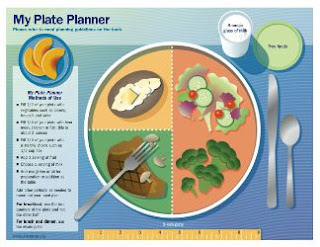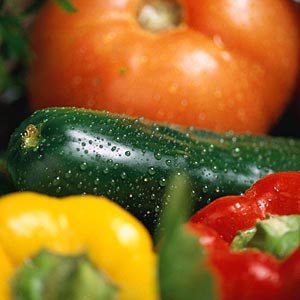
Despite the fact that many of my patients have told me they love them, I’d never eaten okra. No good excuse. The potential sliminess just scared me. So I brought in a special correspondent for this spring’s okra report.
Citypixie lives in NYC but hails from Florida so she knows her southern veggies.
Okra is definitely worth a try nutritionally. It’s only 25 calories per ½ cup serving with 2g of fiber per serving. Part of that fiber is mucilage, a type of soluble fiber and the source of the potential slime. Mucilage (I cringe every time I type that) is also an effective thickener which is why okra is so essential in gumbo. In addition to the fiber, okra is a good source of vitamin B6 and folic acid.
Citypixie convinced me to buy okra and try her VERY simple recipe. It takes 30 seconds to prep (rinse okra – do not cut their tops off!!!!) and then ten minutes total on the grill (they'll give a little when you press them). The okra pictures you see are of my very first ever okra – and I loved them!!!!!!! Soaked in lime, I gobbled them all up. I always expected them to be bitter but they’re not. Okra has a very mild flavor with a little something different in the center.
Special NYC Veggie Report from Citypixie, Okra Guru
"
FreshDirect has substantially streamlined my food procurement habits in NYC. If you're not familiar with it, FreshDirect is a fantastic NYC-based grocery-delivery service that offers New Yorkers just about everything they want in a slick click-and-buy environment. The only real downside to FreshDirect is that you're kind of on your own for meal-time inspiration as nothing can replace the sensory experience of wandering around the market and discovering something new and/or not generally a part of your standard grocery list. (The upside is that I can get my beer, juice and bottled water delivered to my door!)
This weekend I convinced my husband to take a trip to a real "brick and mortar" grocery store in Redhook, Brooklyn. Not just "a" grocery store, but the very beautiful and catacomb-like
Fairway Market. For those of you not familiar with Fairway, Fairway appeals to foodie elites and local-yokels alike because of the sheer variety of offerings (there aren't many grocery stores that carry
sea beans and saltines!) and totally reasonable prices. Fairway is piled high with a panoply of tempting seasonal vegetables and fruits. If you can't find inspiration here, you're in trouble.
Okra isn't exactly "off" my grocery list, as I grew up eating it, but it isn't firmly "on" it either. When I place my FreshDirect order, I tend to be a creature of habit, so once an ingredient finds itself out of rotation, I'm probably not going to be eating it for awhile! Luckily there was a boatload of fresh okra in the specialty produce section beckoning me at Fairway this weekend. It kind of cracks me up that okra is considered a specialty veg (or is it a fruit?) since it was such a staple of my Southern-style family supper, but everything is relative. I never heard of
Fox's U-Bet soda until I moved north of the Mason-Dixon line, which apparently made me a food-philistine up until the point of that discovery!
As "specialty vegetables" go, okra is certainly an acquired taste. Most folks who've had and don't like it, have had their okra in a gooey (probably overcooked) stew with canned tomatoes. While this viscous texture is appealing in many non-western cuisines (i.e. the Japanese love their fermented soybean natto), it is understandably not so popular here in the states where "slime" doesn't conjure up the best images and experiences for most people. Honestly, I don't really care for stewed okra either. Fried okra is a different story, but I think a fried shoe (if it was fried and seasoned correctly) would probably be delicious. Indian and Southeast Asian cuisines incorporate okra into many of their dishes, and I'm thrilled to get my okra in a restaurant, but it isn't likely that I'll be whipping up a ghee, dal, naan or paneer at home anytime soon.
So what's a no-fuss cook to do when she finds a gorgeous pile of okra at the market? Grill it! I have to admit, I didn't come up with this concept on my own – I recently ordered the okra special at a quirky neighborhood Japanese-Vietnamese haunt,
Hoi An. I was blown away with its simplicity and powerful unexpected flavor! Best of all, the gooeyness factor pretty low, which adds to the appeal.
 Citypixie’s Grilled OkraServes 2
Citypixie’s Grilled OkraServes 2Prep time: 30 seconds
Grill time: 10 minutes
15-20 stalks of washed fresh okra
1 T canola oil
Sea salt (I like
Halen Mon)
Fresh limes
Preheat a lightly-oiled cast-iron grill-pan. If not canola oil, be sure to use an oil with a high smoke-point. Get the grill hot, hot, hot, then place the okra on the grill. After about 5 minutes, turn the okra so that both sides get grilled. The okra should have grill marks, but still look vibrantly green and plump. Don't over-grill the okra or the okra will become a viscous gooey hot mess. Once the okra is cooked, plate it. Mix few pinches of sea salt with the juice of a lime. Dip the okra in the lime-salt mixture as you eat it.
Easy and yummy!"
Citypixie also recommends roasting the okra which I tried the next night. I tossed the okra with 1 T olive oil, sprinkled them with Aleppo pepper (pick whatever spice you like), spread them out in a single layer on a baking sheet, and put them into a 450 degree oven for 12 minutes. Just as tasty as the grilled okra.
I now crave okra and need to get more. I bought mine at the local Indian grocer for $1.34/lb. If your supermarket doesn't carry fresh okra, check out your closest ethnic grocer.




 Spicy Cauliflower Chickpea Soup
Spicy Cauliflower Chickpea Soup

































